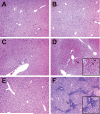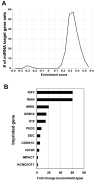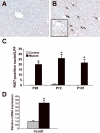Hepatic function is preserved in the absence of mature microRNAs
- PMID: 19127519
- PMCID: PMC2635423
- DOI: 10.1002/hep.22656
Hepatic function is preserved in the absence of mature microRNAs
Abstract
MicroRNAs (miRNAs) are small noncoding RNA molecules that regulate gene expression through partial or complete complementarity with target messenger RNAs. The function of miRNAs in normal liver physiology is largely unknown. We address the role of Dicer1 in the differentiated liver. We derived mice lacking Dicer1 function in hepatocytes and assessed the loss of mature miRNA via quantitative polymerase chain reaction. Gene expression microarray analysis was performed on liver RNA from mutant and control mice. Liver sections from mutant and control mice were examined and liver function tests were performed. Mice lacking Dicer1 function in hepatocytes appeared and behaved normally. Despite the loss of mature miRNAs, hepatic function was maintained, as reflected by normal blood glucose, albumin, cholesterol, and bilirubin. However, mutant mice between 2 and 4 months of age exhibited progressive hepatocyte damage with elevated serum alanine aminotransferase and aspartate aminotransferase. Liver mass was increased in mutant mice, as were cellular markers of both proliferation and apoptosis. Microarray analysis indicated large-scale changes in gene expression, with increased expression of many miRNA targets, particularly imprinted genes.
Conclusions: Loss of miRNA processing in the liver at late gestation has a remarkably mild phenotype, suggesting that miRNAs do not play an essential role in hepatic function. However, miRNA deficiency results in hepatocyte apoptosis, hepatocyte regeneration, and portal inflammation. Finally, microarray analysis of gene expression in the mutant liver supports a previously hypothesized role for Dicer1 in the repression of imprinted genes.
Figures






References
-
- Ambros V. microRNAs: tiny regulators with great potential. Cell. 2001;107:823–826. - PubMed
-
- Ambros V. The functions of animal microRNAs. Nature. 2004;431:350–355. - PubMed
-
- Bernstein E, Caudy AA, Hammond SM, Hannon GJ. Role for a bidentate ribonuclease in the initiation step of RNA interference. Nature. 2001;409:363–366. - PubMed
-
- Hutvagner G, McLachlan J, Pasquinelli AE, Balint E, Tuschl T, Zamore PD. A cellular function for the RNA-interference enzyme Dicer in the maturation of the let-7 small temporal RNA. Science. 2001;293:834–838. - PubMed
Publication types
MeSH terms
Substances
Grants and funding
LinkOut - more resources
Full Text Sources
Other Literature Sources
Molecular Biology Databases
